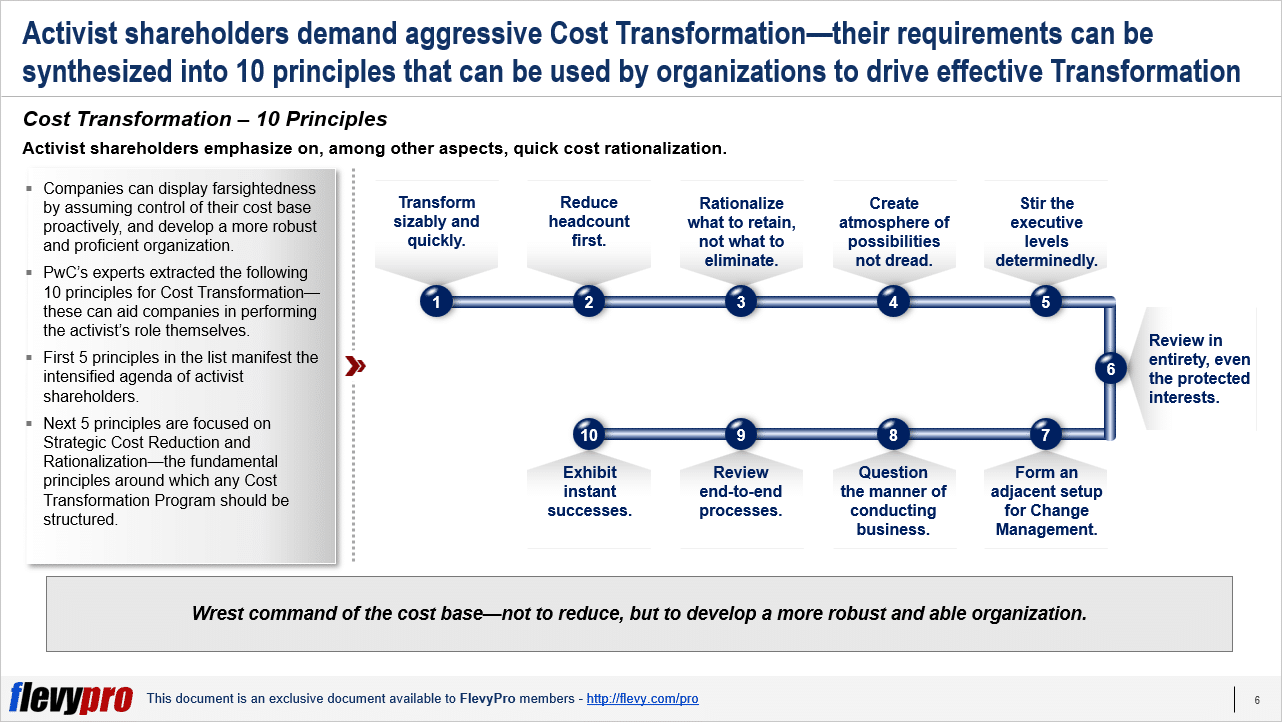Editor's Note: Take a look at our featured best practice, Cost Reduction Opportunities (across Value Chain) (24-slide PowerPoint presentation). Though there are multiple levers to maximizing an organization's profitability, costs are the most directly controllable by any organization. Profitability is being challenged by increased costs, stagnated revenue growth, and increased capital costs in today's economic climate.
Therefore, a [read more]
* * * *

Cost Transformation is a reality that every organization has to face, several times, in its period of existence. Proper and enduring Cost Transformation provides an opportunity to reformulate an organization’s complete course. It may result in divestiture of established businesses, even profitable ones, if they do not match the Strategy or the enterprise’s most distinguishing capabilities.
Such Transformations are increasingly being spearheaded by Activist Shareholders in recent times.
Activist shareholders are investors in a company (usually hedge funds) that demand drastic changes to how business is conducted in organizations. Activist investors routinely expect management teams to reduce costs drastically over a relatively short period of time.
Data analysis indicates that activist shareholders returned double digit rewards for investors compared to the single digit returns by other investment funds. Investors are increasingly demanding activist funds in their portfolios.
Organizations should prepare for such funds by presciently looking at what changes such activist shareholders are demanding and proactively adopting an Enterprise Cost Reduction Approach.
Organizations can learn from activist investors during times of tremendous cost containment pressure, such as during a recession.
The activist investor approach to Cost Transformation, albeit unconventional, can be adapted to help organizations navigate through times of uncertainties. Companies can display farsightedness by assuming control of their cost base proactively, and develop a more robust and effective organization.
PwC’s experts extracted the following 10 principles for Cost Transformation—to aid companies in performing the activist’s role themselves.
-
- Transform sizably and quickly.
- Reduce headcount first.
- Rationalize what to retain, not what to eliminate.
- Create atmosphere of possibilities not dread.
- Stir the executive levels determinedly.
- Review in entirety, even the protected interests.
- Form an adjacent setup for Change Management.
- Question the manner of conducting business.
- Review end-to-end processes.
- Exhibit instant successes.

First 5 principles in the list manifest the intensified agenda of activist shareholders. Next 5 principles are focused on strategic cost reduction and rationalization—the fundamental principles around which any program should be structured.
Let us delve a little more deeply into some of the principles.
1. Transform Sizably and Quickly
Past practice of slashing costs, for e.g. by 10% over a 5-year period, do not fly with activist shareholders any more. They demand significantly more and that too, over a fairly shorter period e.g. 20% or more in 24 months, with half of it in the first 12 to 18 months.
Transforming costs sizably and quickly has been shown to provide considerable leverage. Study of 29 cost reduction efforts showed that of the 29, the companies which went big and fast were able to achieve 33% more cost reduction in almost 1/3rd of the time.
2. Reduce Headcount First
Conventional approach to cost reduction advocates eliminating unnecessary work first, then reducing the head count accordingly. This takes quite a long time to accomplish due to various reasons. New approach takes the head count reduction before process and system change.
Reducing head count first produces a void, the residual workforce has to step up and fill that space in order to keep their part of the business running. In stepping up, the remaining workers are forced to prioritize and handle jobs thus creating more effective and efficient processes.
3. Rationalize What to Retain, Not What to Eliminate
Entire expenditure is investment. Each cost is an option—not regarding what to slash from the budget, but about where to invest. Expenditures have to be rethought from their starting points—each expense to be considered eliminable. Correct choices are the ones that reduce the disparity between Strategy and Execution.
Interested in learning more about 10 Principles of Cost Transformations? You can download an editable PowerPoint presentation on 10 principles for Cost Transformation here on the Flevy documents marketplace.
Do You Find Value in This Framework?
You can download in-depth presentations on this and hundreds of similar business frameworks from the FlevyPro Library. FlevyPro is trusted and utilized by 1000s of management consultants and corporate executives.
For even more best practices available on Flevy, have a look at our top 100 lists:

33-slide PowerPoint presentation
This document discusses various cost reduction methodologies and concepts, including the following: Process Optimization, Strategic Sourcing, Shared Services, Business Process Outsourcing.
This comprehensive guide delves into the intricacies of cost reduction, providing a robust framework for
[read more]
Readers of This Article Are Interested in These Resources

30-slide PowerPoint presentation
A question faced by many business leaders in today's dynamic, uncertain, and changing business environment is: Is our organization "Fit for Growth?"
In most cases, unfortunately, the answer to this question is "no." Reasons include the manner in which costs are managed and resources
[read more]

97-slide PowerPoint presentation
This presentation is a training document about strategic cost reduction (SCR) used by a major consulting firm in a cost reduction project. The main objectives of the presentation is
- Provide context on our relationship with Client X
- Share our point of view on SCR
- Review our SCR
[read more]

36-slide PowerPoint presentation
Rationalization of controllable expenses is an integral component to any strategic cost reduction engagement. Often, an organization must identify and size potential saving opportunities within controllable expenses. To ensure that these savings can be realized and sustained, a holistic
[read more]

33-slide PowerPoint presentation
According to McKinsey, when the COVID-19 crisis began to affect companies worldwide, the preliminary response of CEOs and CFOs was all about survival: freeing up cash and resources to keep the lights on and the doors open. The liquidity crisis triggered by the sharp disruption in economic
[read more]






